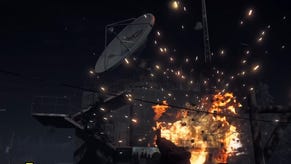Is Far Cry 2's tech really more advanced than Far Cry 5's?
The answer is yes - but also categorically no.
Under Ubisoft's stewardship, the Far Cry franchise is now celebrating its 10th year - a full decade of series entries and offshoots that have seen the focus of the gameplay and the technology shift dramatically. And this has led to some interesting YouTube offerings from Mark Brown and CrowbCat, showing what look like substantial engine downgrades over the years. So what's going on here? Has the massive increase in processing power provided by the current-gen consoles been matched with a simplification in aspects of the technology?
The answer is both yes and categorically no. Going hands-on with both games reveals that the technological focus of Far Cry 2 is very different to the new title, with a more hardcore focus on simulation and perhaps less on player satisfaction and actual 'fun'. The fact is that Far Cry 2 hails from a very different era in game development, with a somewhat unique emphasis for its development and marketing. Far Cry 2's advertising and lead-up to its launch focused heavily on the technical aspects of the newly crafted Dunia Engine. Prior to its October 2008 release, the public knew very little about Far Cry's 2 plot and gameplay structure. Instead, technology was the focus. Pre-release videos showcased the extensive use of real-time shadows, cloud formation and weather, backed by an impressive time of day lighting system.
The Dunia engine went further though - much further. GDC videos also showed off one of Far Cry 2's more famous aspects, where trees and foliage moved based upon wind and the forces around them. Foliage was shown to be dynamically deformable, having destructive properties where it could burn away, blacken, or be shot or hacked into pieces. These trees and brush would even grow back in real-time, sprouting branches and budding out leaves as trees do in the real world. Big, expensive, high fidelity simulation was the talk of the town, and it was a way to get attention for the game.
Although it was played up heavily in marketing, it was not all just talk. Vast performance and visual differences were starting to crop up in PC releases as the hardware there grew in capabilities. Direct X 10 was being heavily pushed and marketed by Microsoft. Its advertisement and usage is telling: the best graphics and simulation were actively being pushed, and both Microsoft and game publishers wanted the world to know that this technology was going to be found on PC - where ambitious systems-based technology powerhouses were to be released.
The vision was straightforward enough - graphics and simulation created a sandbox of tools where the person playing could imagine and think up gameplay for themselves, on the fly. But perhaps developers went too far, as some of the extremes of technology seen in this period were implemented for their own sake, with little payback from gameplay. For example, take the ability to break down trees limb by limb in Far Cry 2. It's impressive to behold, but the traditional approach of swapping in a separate model at a certain damage threshold would achieve similar results and it's hard to believe that the average gamer would feel short-changed.
Technology dominated the design and execution of many top-tier games of that era and some might say that the release of Crytek's epoch-making Crysis is the reason why. It was the game that defined the concept of technology pushing gameplay systems, with such mind-bendingly insane graphics on release that games today are still playing catch-up with aspects of it. How many games have procedurally breaking and touch-bending vegetation? How long did it take for filmic per-object motion blur to become standard? How many games use self-shadowing parallax occlusion mapping or other highly detailed technology to such an insane degree?
In that context, of course Far Cry 2 has lots of simulation for its own sake. It was the trend in 2008 and Crysis was the game to beat, though where that focus shines in Crysis' sandbox, Far Cry 2 arguably falters. A lot of those uncompromising simulation aspects are not exactly fun - contracting malaria for example. Far Cry didn't dumb down or become technologically less impressive - it evolved into something more ambitious in different ways, becoming more easily accessible, more streamlined and more performant. Today's Far Cry 5 can exceed 60 frames per second on mainstream CPUs and graphics cards - Far Cry 2 couldn't on contemporary hardware. In console terms, the new game is far more refined and optimal than FC2 was in its day on PS3 and Xbox 360.
Far Cry 5 is more streamlined and more GPU-focused, but that does not mean that it's lacking in sandbox simulation. Dunia is still pulling its weight, just in a different direction. Its stunning implementation of volumetric fog and lighting is a great example of this. Unlike Far Cry 2, which uses a cheap screen space crepuscular ray effect which was popular at the time, Far Cry 5 has fully volumetric, world space-based, lit fog, with variable density. So the sun, shadows, and any light sources shine through it. The beginning of the game uses this to great effect to limit the player's movement and visibility. It obscures your line of sight, makes distant enemies unreadable, or is generally blinding. Technology there is influencing gameplay.
The game is full of zany systemic gameplay moments just like its predecessors, but other changes that have been highlighted are also easily explained. Rocket shells no longer operate on a parabolic trajectory because it's harder for the player to aim - the tech is clearly still there because that's exactly how grenades operate, but taking on a helicopter with an RPG while compensating for the shell's arcing trajectory would likely be more difficult and less satisfying. Similarly, bullets penetrating materials is still a feature, except that now it's an option you buy in the form of armour-piercing bullets.
Far Cry has also evolved dramatically in many other ways compared to Ubisoft's first stab at the franchise. The world of Far Cry 2 is simpler in terms of object density and really, it's not even an open world as such. It's more of a series of gameplay areas connected by cunningly decorated 'corridors' giving the illusion of an open world. The move to a much wider, open sandbox actually occured in Far Cry 3.
Owing to RAM increases on the current-gen consoles, Far Cry 5 actually performs well on consoles - something that definitely wasn't the case on Xbox 360 and PlayStation 3. If CPU resources are clawed back by cutting back on some of Dunia's original, meticulously focused systems, they're being spent elsewhere, processing the draw calls required in creating a richer, fuller world with more objects and more advanced AI. One thing to bear in mind is that while memory and GPU power have increased massively from one console generation to the next, CPU capabilities didn't enjoy quite same level of enhancement and some compromises need to be made as a result.
Overall, Far Cry 5 is a natural evolution of the fascinating Dunia Engine technology, which debuted in an era when tech defined gameplay to an unprecedented degree. The shift away from such a hardcore focus has been gradual from one Far Cry series entry to the next and represents Ubisoft's attempts to put the emphasis more on fun and gameplay. Far Cry 2 is unwieldy, frustrating, yet ambitious. Learning from the successes of prior series entries, Far Cry 5 is perhaps less complicated, but it's clearly more polished and more advanced in terms of the quality of its visuals. Most importantly, however, the technology is geared more toward delivering fun.




















